A one-of-a-kind route to Antarctica
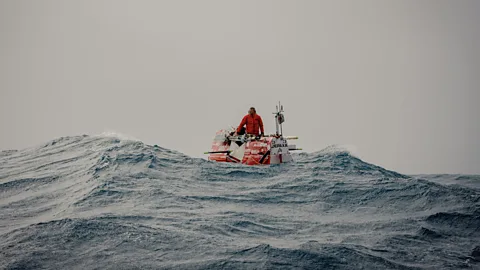 Alfonso d'Ors
Alfonso d'OrsSpanish adventure athlete Antonio de la Rosa attempted to row alone through the roughest seas on the planet to Antarctica. Very little went according to plan.
Icy waves and Antarctic winds up to 120km/h kept Spanish adventure athlete Antonio de la Rosa's 7m rowboat listed over to port for days on end. Departing Cape Horn, the southernmost point of South America, on 7 January 2023, de la Rosa rowed south towards Elephant Island, 903km away in the Antarctic archipelago. He relied on a climbing harness to keep him from falling out of the boat as rough seas tossed him around like a cork. Ocean currents pushed him east of his course, no matter how hard he rowed against them.
De la Rosa had set out in the tiny boat, which he named Ocean Defender, to be the first person to row alone to Antarctica. Like the early Spanish explorers in the region, he was travelling without fossil fuels, using only his own strength rowing and taking advantage of ocean currents and wind. When he finished the journey, he had travelled 2,380km, risking his life in the unforgiving Antarctic cold.
Beyond the athletic challenge, de la Rosa wanted to document the state of the Southern Ocean. Sitting right at sea level, he had a much more intimate experience with the ocean than passengers on the typical cruise ships that venture through these dangerous waters.
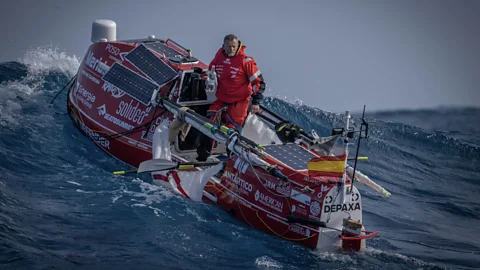 Alfonso d'Ors
Alfonso d'Ors"Everybody has seen islands of plastic in the ocean on TV, but I've seen it with my own eyes," de la Rosa said, describing his ocean crossings in other parts of the world. He assumed that the Southern Ocean would have similar traces of humanity but wanted to see it for himself.
Waves regularly reach 12m high in the violent seas between Cape Horn and Antarctica. A rogue wave is "more than twice the size of the waves around it", according to Ally Hirschlag, editor at The Weather Channel. "Rogue waves can cause severe damage and loss of life if they hit a ship in the open sea."
They were a risk that kept de la Rosa on edge throughout his 26-day voyage, even though the Ocean Defender had been built in Spain to de la Rosa's specifications and designed to right itself from the hardest blows the Antarctic waves could deliver.
The rogue wave that killed a cruise ship passenger on an Antarctic voyage a little more than a month before de la Rosa began his expedition was estimated to have been between 21m and 26m high. And while it can be a harrowing experience to traverse these rough seas in a 300m cruise ship, the ordeal is infinitely more dangerous in a little rowboat, no matter how carefully crafted it is.
The raging waves crashing over the rowboat tipped it 90 degrees onto its side many times, but the first time de la Rosa's boat rolled a complete 360, his heart was in his throat.
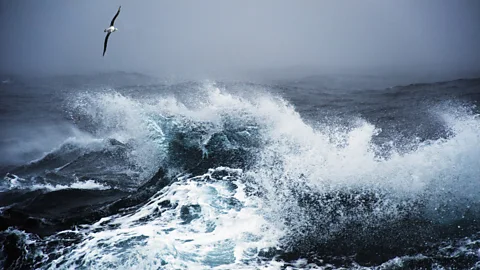 Mike Hill/Getty Images
Mike Hill/Getty Images"It really scared me, to be honest," he told me. "Even though I knew the boat would right itself, the impact of the wave was so hard. The fifth time a wave rolled the Ocean Defender, it rolled a full 360 twice in a row." Fortunately, he was inside the boat's small cabin each time it happened.
It is not easy to scare de la Rosa, who has completed numerous solo adventures. In 2014, he won the French competition Rame Guyane, rowing 4,700km solo from Senegal to French Guiana in 64 days. In 2019, he crossed more than 4,000km of the Pacific alone from California to Hawai'i in 76 days on a stand-up paddle board, documenting the massive garbage patches in the Pacific on social media.
This 2023 expedition has made him the first person to row alone as far south as the 59th parallel.
As a safety measure, the Chilean Navy required de la Rosa to hire a rescue boat in case of an emergency. It was an 18m sloop that only stayed close enough to be of any real use the first three days of the voyage. After that, de la Rosa was truly on his own.
"I couldn't make any errors because it could have taken three to four days for the boat to get to me," de la Rosa said. "Psychologically, that was the hardest part, without a doubt."
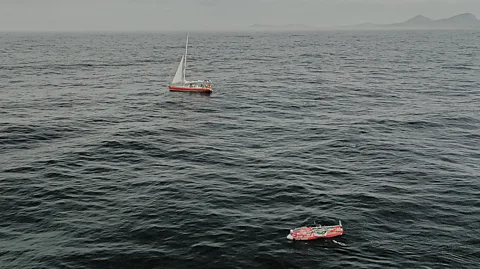 Alfonso d'Ors
Alfonso d'OrsThe frigid waves and wind presented de la Rosa with external challenges, though the physical test didn't end there. De la Rosa slept little during the expedition, usually in one-hour catnaps. The first several days, he barely had time to eat as he rowed more than 20 hours per day, trying in vain to keep a southerly course against currents and winds that pushed him north-east.
The first part of his itinerary was to row 903km from Cape Horn to Elephant Island through what is known as the Drake Passage. Along with his adventure and athletic challenge, de la Rosa wanted to bring back a piece of Spanish history.
"I want people to know that these waters were named Mar de Hoces before people called it the Drake Passage," said de la Rosa, explaining that the Spanish sailor Francisco de Hoces sailed around Cape Horn in 1525. "[English explorer Sir Francis] Drake only sailed through the Strait of Magellan," de la Rosa added. "He never sailed south of Cape Horn. I think we should change the name back to Mar de Hoces."
The second part of his journey was to raise the boat's small sail and follow Sir Ernest Shackleton's 1916 journey from Elephant Island to South Georgia, a remote British Overseas Territory 1,400km east of the Falkland Islands.
Shackleton set out in 1914 to be the first to cross Antarctica on foot, though his ship the Endurance was caught in pack ice, preventing him from even reaching the continent. He is best remembered now for his extraordinary rescue mission, which included sailing a 7m lifeboat from Elephant Island to South Georgia.
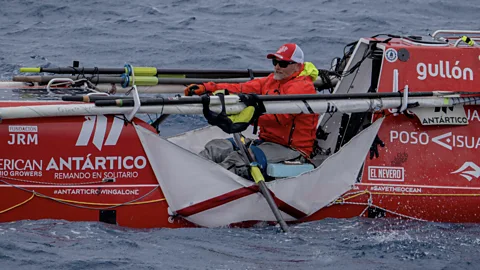 Alfonso d'Ors
Alfonso d'OrsBut much like Shackleton's failed attempt to reach Antarctica, very little went according to plan for de la Rosa, and his solo expedition quickly became a survival test.
On day 12, de la Rosa reached the 55th meridian, where Elephant Island is located. Unfortunately, he was still 200km north of the island. With strong currents and wind gusts continually pushing him east, there was no way to row due south to the island. Disappointed, he changed course and headed north-east, setting himself a new goal of rowing to South Georgia, rather than sailing.
After two weeks, humidity inside the cabin and the impact of so many waves were breaking down de la Rosa's technology. His autopilot broke after the first week, but his other systems fared better until the end of the second week. The autopilot moved the boat's rudder, allowing de la Rosa to focus on rowing while the boat maintained its course. Other essential systems powered by solar panels included a desalinator for potable water, a GPS that relayed his current location to his website and a VHF radio that made his location visible to other boats. On day 14, he raised the sail to try reaching land before all his navigational systems failed.
The biggest shock came on day 19 when he realised the boat was listing starboard and riding low in the water. He was horrified to discover several compartments in the bow and stern that contained electronics and the solar panels' batteries had flooded.
"In the stern, there was between 150 and 200 litres of water," he said. "Luckily, I was able to bail it out. I did some tests with an ammeter and saw that the batteries were still charged."
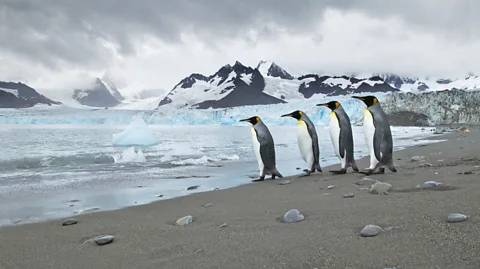 Enrique Aguirre Aves/Getty Images
Enrique Aguirre Aves/Getty ImagesThe water entered after silicon seals detached from holes where cables passed from the bow to the stern. To patch the holes, he had to remove the cables that powered systems to measure water temperature, depth and wind speed.
For 12 days, he sailed north-east, increasingly limited by damaged navigational systems. By the time de la Rosa arrived on South Georgia he had travelled 2,380km in 26 days through the roughest seas on the planet. He crossed almost twice the distance Shackleton faced from Elephant Island to South Georgia and is in even more awe of the 1916 feat than before.
"With Shackleton's boat, it would have been brutal," de la Rosa told me. "It must have been a terrifying voyage."
The White Continent continues to draw people south, despite the dangers. According to the International Association of Antarctica Tour Operators (IAATO), 73,670 people visited Antarctica on cruise ships in the 2019-2020 season. They estimate that the 2022-2023 season could be back to pre-pandemic levels.
Even with tens of thousands of people visiting the region, de la Rosa was happy to see no refuse on his oceanic expedition or in South Georgia. Dolphins occasionally accompanied him and petrels sailed by, giving him quizzical looks.
"Even though it seems humans have left our mark everywhere, I barely saw it here," de la Rosa said. "It's something we should be proud of and show the rest of the planet that it's possible."
---
Join more than three million BBC Travel fans by liking us on Facebook, or follow us on Twitter and Instagram.
If you liked this story, sign up for the weekly bbc.com features newsletter called "The Essential List". A handpicked selection of stories from BBC Future, Culture, Worklife and Travel, delivered to your inbox every Friday.
